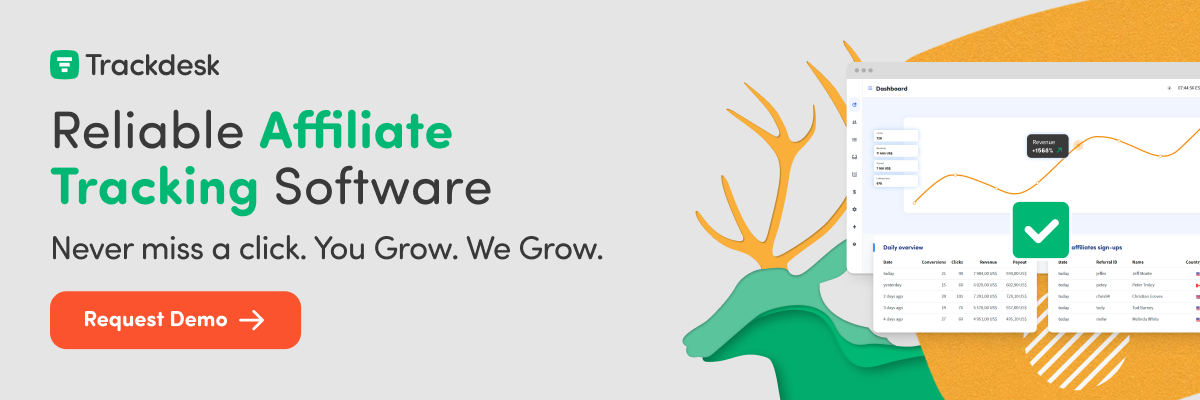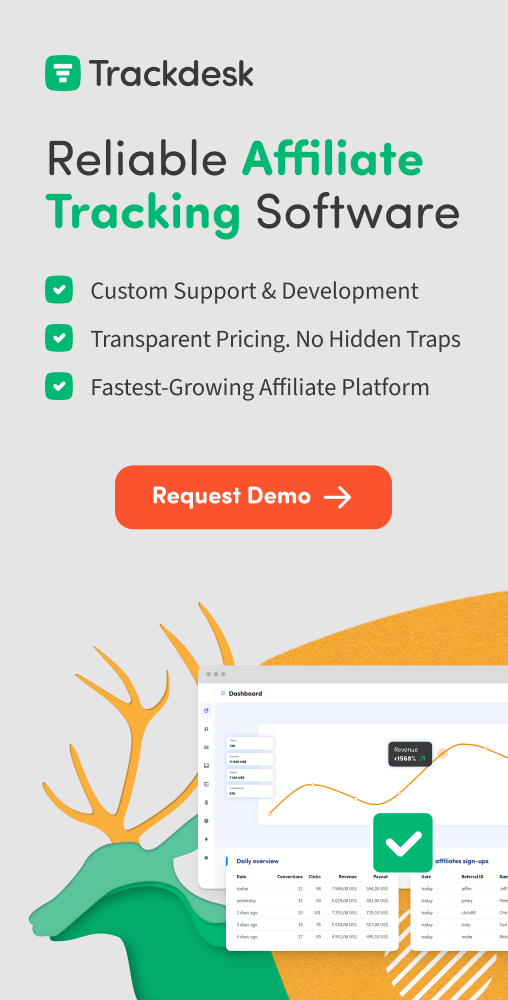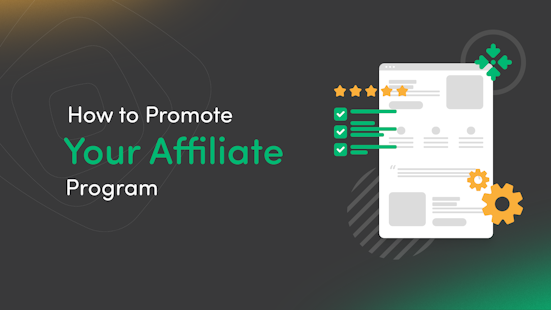
How to Promote Your Affiliate Program: Focus on These 6 Areas
: Learn how to promote your affiliate program by focusing on six key areas. Increase your reach, visibility, and trust to drive success.
Learning how to promote an affiliate program efficiently is like having a growing sales force for free. Promoting it creates a network of enthusiastic brand advocates, such as credible bloggers, influencers, and reviewers who organically recommend your product to their followers. This builds trust and credibility for your brand.
Moreover, affiliates target specific niches, reaching audiences you might not access otherwise. Skip promotion, and you miss increased sales and valuable insights from affiliates who know their audience best.
With 81% of brands having affiliate programs, you need a promotion strategy to gain an edge. Let's explore key affiliate program tactics for promoting an affiliate program efficiently.
1. Build a Strong Foundation
A solid foundation ensures you have all the necessary elements to attract and retain top affiliates.
Build a Well-Designed Affiliate Program Page
One of the primary goals of all your promotions is to get people to visit your affiliate program page. It's the headquarters of your entire affiliate setup. It should clearly outline all the relevant information for joining your program, and the layout must be professional-looking and uncluttered. So, make sure to hire a professional to help you with this and ask them to make a good cover letter to prove their skills and experience in creating effective marketing materials.
Let's take a look at the Skyscanner affiliate program page:
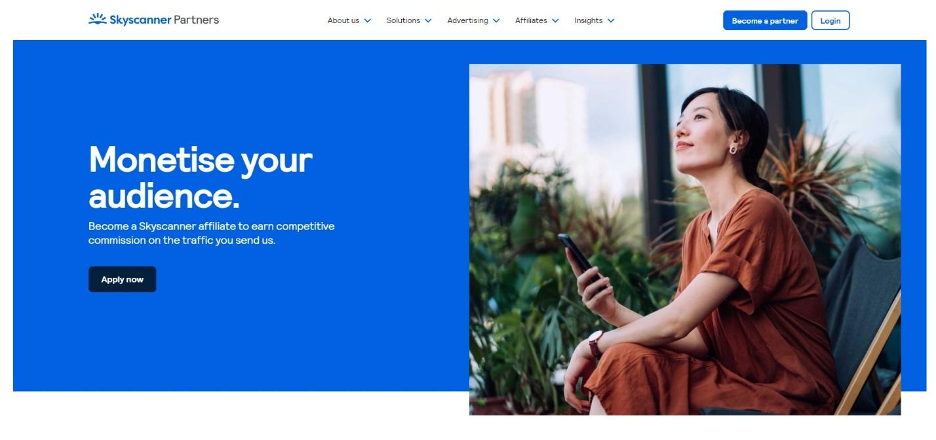
What should your affiliate program page include?
Clear Value Proposition: What differentiates your program from other affiliate programs in your niche or industry? Your affiliate program page must articulate the unique benefits affiliates will get when they join your program. You can list the perks so they're easy to digest or use one-liners to grab attention quickly. You can also use benefit-driven statements that create a sense of belonging and desire to take action.
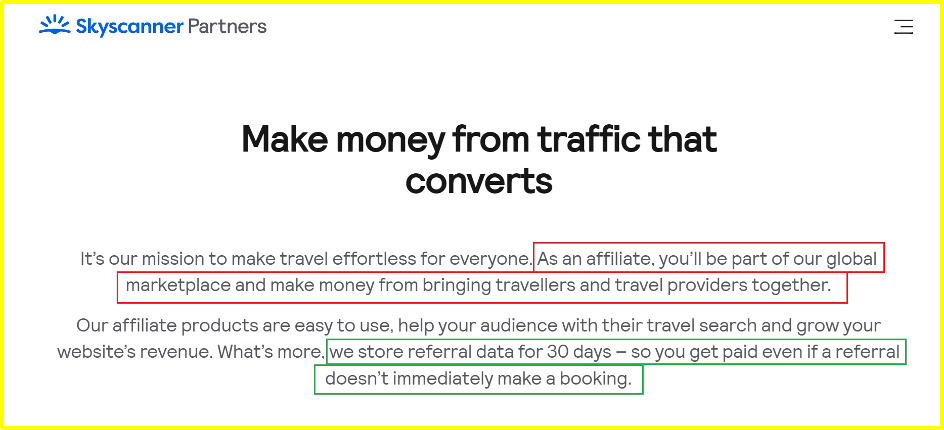
Easy Signup Process: Streamline the application process to minimise friction and encourage participation. Don't overwhelm your potential affiliates with a lengthy application or excessive required fields. You can embed the application form or add a link to your affiliate program application. You can also offer social login so they can sign up using their existing email or social media account.
In Skyscanner's case, they provided a link for the application page:
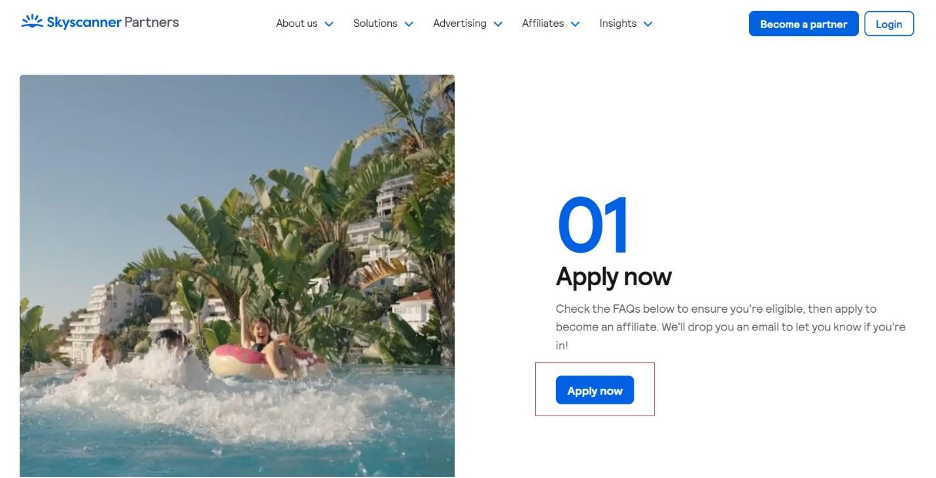
The new signup page mentions that the whole process will only take five minutes:
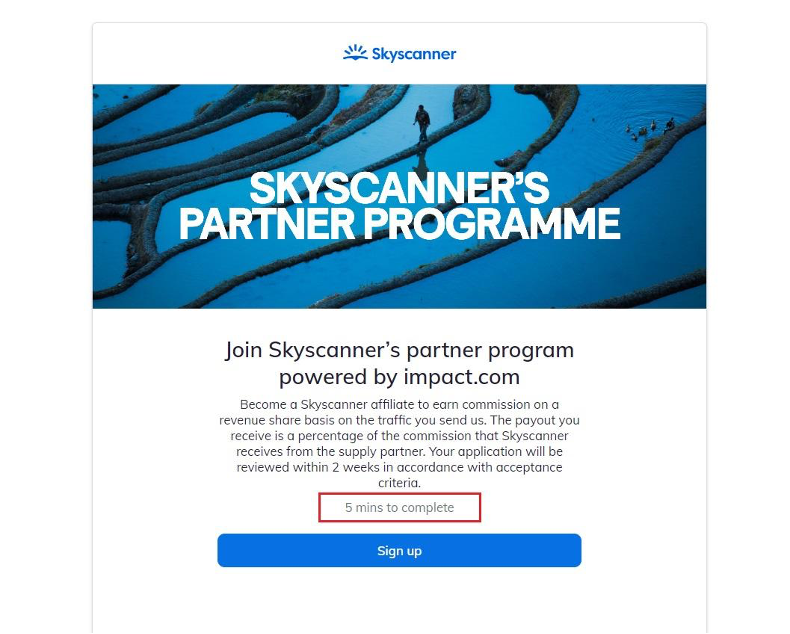
Attractive Commission Rates: Do you provide a flat commission rate or percentage for every successful sale? Do you offer bonuses to top affiliates? How quickly will your affiliates earn money? While genuine enthusiasm for your product plays a role, a reasonable commission rate is vital to attracting top-tier affiliates.
If you can't offer an above-average rate, try to be competitive and provide the best deal. Check industry standards for valuable benchmarks. Also, factor in your product's value, conversion rates, and affiliate effort. Different commission rates are available, so choose the one that is favourable to your business and fair to your affiliates.
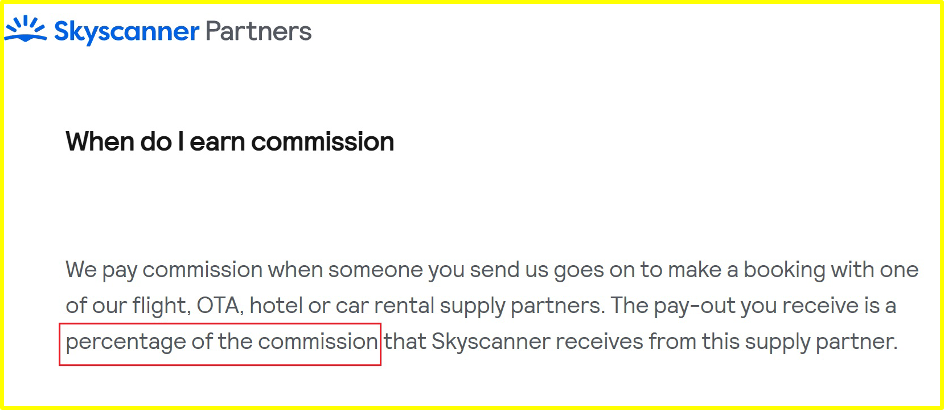
Detailed Program Information: Transparency is a big deal in affiliate marketing. Your page should clearly explain your program's Terms and Conditions, tracking methods, payment options, and availability of marketing materials. If your program has specificity, like acceptance criteria, it must be included on this page. Add an FAQ section to expand on relevant information.
Include the Program in Other Places on Your Website
Your affiliate program already has an HQ. The next step is to build "offices" where potential affiliates can easily find your program. These offices are different parts of your website that can boost your program's visibility. The next step is to create compelling website headlines where potential affiliates can easily find your program.
In general, the affiliate program link is seen on the website's top menu. You can add a link at the bottom menu as well, just like what HubSpot did.
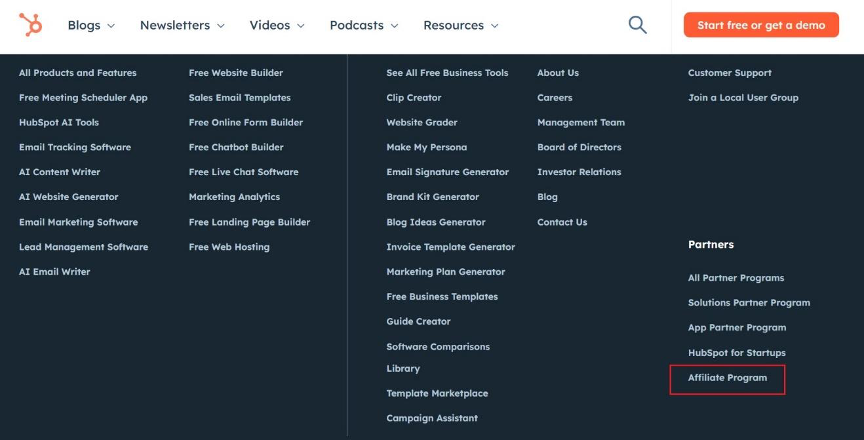
Where else can you integrate your affiliate program into your website?
Banners: Strategically add eye-catching banners all over your website’s high-visibility pages, like home or product pages, to direct visitors to your program page. You can use a heatmap to show which pages your visitors engage the most.
Don't overcrowd the banner with text; use bold fonts and visually appealing images instead. Add five elements: an image, the title, brief info, CTA, and a logo. Experiment with different banner sizes to cater to various website layouts.
Call-to-Action (CTA): Don't just leave it to chance. Use a strong CTA to encourage visitors to join your affiliate network. Encourage visitors by highlighting a benefit like "Let's Grow Together" or "Scale Your Success.” Play on this feeling of not missing out on a potentially profitable income by joining the program.
Blog Posts: Revise high-performing blog posts and organically link your affiliate program. Add CTA to introduce your program. Alternatively, create valuable content on affiliate marketing, like a long-form article. This is also a good way to show your experience and expertise in affiliate marketing and can inspire confidence in potential affiliates to join your network. Topics can include a list of successful affiliates, tips to earn more with affiliate marketing, and reasons to use robust affiliate tracking software. Use the article length to elaborate and add links to your program.
2. Expand Your Reach
Keep recruiting affiliates from different industries and niches to maintain a productive affiliate program. Diversifying your pool of affiliates enables you to reach a broader audience and explore untapped markets.
Run Targeted Email Campaigns and Newsletters
About 73% of marketers worldwide prioritise email marketing (more than SEO and paid search) as a top-tier marketing channel. Learning how to promote an affiliate program via email allows you to reach potential affiliates who are already existing customers.
Targeted Campaigns: Create an email list of existing customers who will likely be your brand advocates. You can validate email addresses to see which ones are correct and active addresses to make sure to reach the right people and use the right customers for your campaign.
These can be top customers or repeat buyers. With a personalised email, invite them to join your affiliate program. Start by thanking them for being great customers and letting them know how they've helped your business.
Continue on the win-win structure of your affiliate program, where they can earn a passive income while your business gains more exposure. Highlight the benefits of being a part of your affiliate network and list the incentives that come with it. Since they're top customers, you can create an exclusive deal for them. This will make them feel valued and open the door to consider your program.
Here's a sample of a recruitment email template that you can personalise:
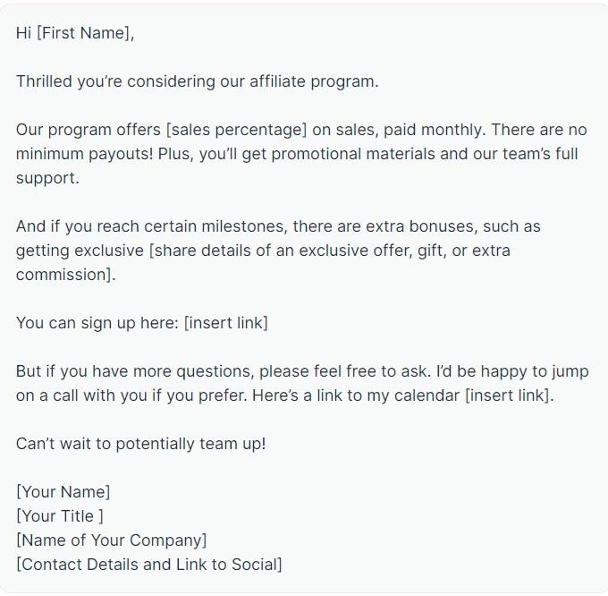
Another version of targeted email campaigns for affiliates is segmenting your email subscribers based on their preferences. Use data insights like past buying behaviour to do so. For instance, segment your subscribers by the top affiliate marketing industries: electronics, fashion, health and beauty, and travel. Send electronic affiliates with a personalised email on new gadgets and tech reviews. Send fashion affiliates personalised emails on the latest trends, style guides, and exclusive discounts on apparel and accessories. While this strategy might be relevant for large retailers with diverse product categories, it remains valuable to consider, especially when the program is already scalable.
Program Updates: Send your email list subscribers with news about your affiliate program. The email can exclusively be about the program, where you'll mention the basics, some updates, and perks of joining your program. Alternatively, you can add a section about your affiliate program to your regular digital newsletter. Sending an email update is a great way to share news about increased commission rates, possible bonuses, new marketing materials, and upcoming promotions.
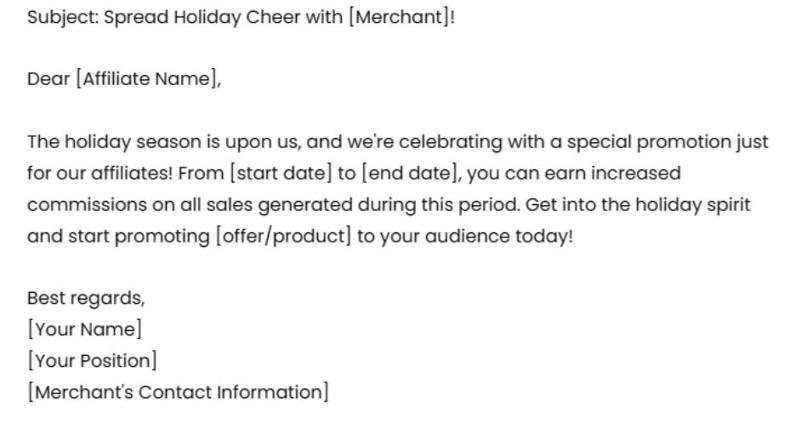
Success Stories: Your affiliate marketing website must have a case studies page. Repurpose a case study and make email content out of it. Alternatively, interview a top affiliate and share Q&A-style email content or shout out to several top affiliates and briefly describe their accomplishments. Sharing success stories is also a great way of making your top affiliates feel appreciated. It can also be a great source of inspiration for other affiliates, especially those new to the program. Show them how your affiliate partners enjoy a steady stream of income and positive experiences from your program.
Build an Affiliate Network
Affiliate networks typically house thousands of affiliates across various niches. This lets you connect with a vast pool of potential affiliates you may not have access to. Furthermore, affiliate networks generally have built-in safeguards against fraudulent activities. Their advanced tracking mechanism ensures you're working with credible affiliates.
Utilise Affiliate Networks: Partnering with an established affiliate network can help you streamline recruitment, management, and tracking of affiliates. A platform like Partnership Managers Marketplace (PMM) can help you build your affiliate network from signing up to scaling. PMM houses premier and experienced partnership managers who can connect you with influential affiliates within your niche and industry. These vetted talents can help you nurture a more personalised relationship with your affiliates, which will foster targeted marketing initiatives.
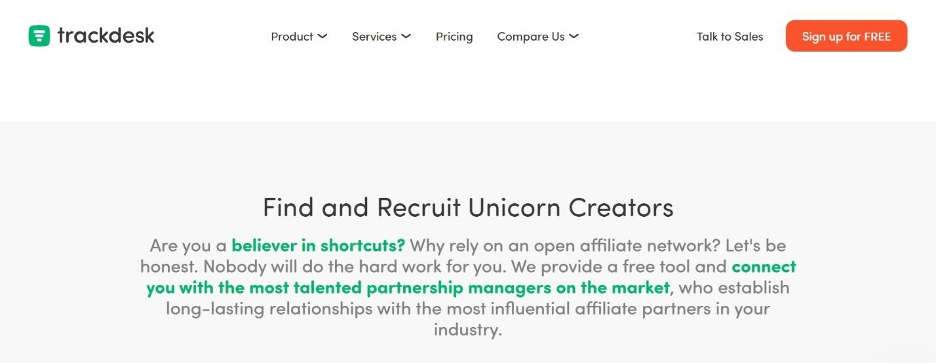
Recruit Strategically: Explore affiliate network dashboards, as 83% of businesses and publishers use this platform to discover new affiliates. You can also look into affiliate networks within your industry or communities relevant to your niche. For instance, if you're promoting financial planning services, visit forums frequented by financial advisors or personal finance bloggers. On social media, look for creators and influencers with highly engaged audiences. They don't necessarily need to have a large following but partner with those aligned with your brand and target market.
3. Optimise for Discoverability
A discoverable affiliate program cultivates organic growth. When potential affiliates can easily find your program and understand its benefits, they will likely join and promote your products. As your program gains traction, more and more affiliates will be attracted to it, and more success stories will emerge.
Integrate Affiliate Links Naturally
Integrating your affiliate program links throughout your online presence is a great way to boost your program's visibility.
Use Paid Advertising: Levering paid ads like Google Ads effectively promotes your affiliate program and targets specific audiences. Paid ads can help you reach potential affiliates who are actively searching for relevant programs. You can also run retargeting ads for visitors who've checked out your affiliate marketing website. Paid ads also contribute to building brand awareness about your program. Even if potential affiliates don't sign up immediately after seeing your ads, they may recall it again if they see your brand on other channels.
See this sponsored ad from an "affiliate program for freelancers" search:

Promote Links on Podcasts and Webinars
Podcast sponsorships are great for reaching targeted customers. But what if you could use them to find new affiliates, too? Affiliates are out there, listening to podcasts just like your audience. By sponsoring shows relevant to your niche, you're not just reaching potential buyers but also potential partners. It's a niche strategy, but when a podcaster talks about your program, they can spark the interest of fellow affiliates. It's a win-win strategy: listeners discover your brand, and affiliates discover a new revenue stream.
The best part of promoting your affiliate program on these platforms is getting clicks even after the live episode ends. You can share the recording with the link of your affiliate program on social media platforms as long as the podcast or webinar topics are relevant. Or you can create slides to present during these webinars and enhance them with free PowerPoint icons to make your content more engaging, and then you can also share these slides with the audience.
Use the Chat Window and Show Notes: Pin your affiliate program in the comment section to make it easy for your viewers and listeners to access. For webinars, you can subtly add them to presentation slides. For webinars, you can use a presentation maker and subtly add them to presentation slides. For instance, Food Blogger Pro always links the sponsor(s) of their podcast on their website and other platforms like Spotify.
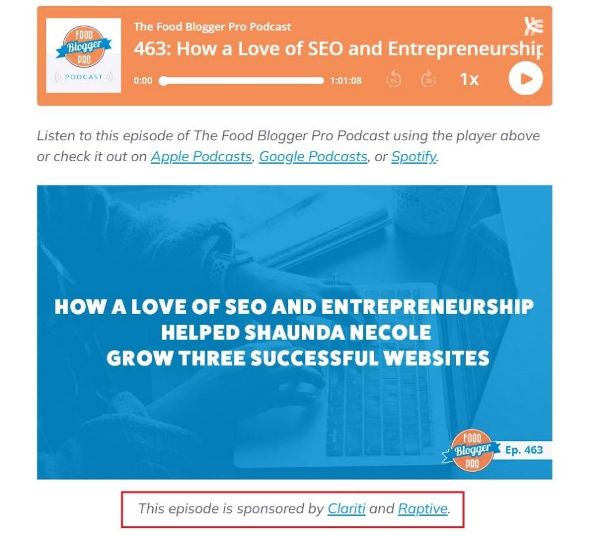
Advertise During the Show: Look for podcasts within your niche with a solid listener base that overlaps your ideal affiliates. Do your due diligence to ensure a natural fit with the podcast's topic, host's style, and audience demographics. If you partner with a podcast that aligns with your brand, it'll be easier for them to advertise your program organically. You can present an outline of what you want to be conveyed and let the podcaster's knowledge and wit integrate your brand to avoid a sales pitch.
Use Display Buttons and QR Codes: Create eye-catching (but not too distracting) display buttons with CTA and put them at the bottom of the screen. You can add the QR codes on the slides and physical handouts. These affiliate program tactics provide quick and convenient ways for attendees to access program details or sign up on the spot.
4.Build Trust and Collaboration
Learning how to promote an affiliate program efficiently goes beyond attracting affiliates. It's also about cultivating thriving relationships with them.
Leverage the Power of Reviews
Positive reviews and affiliate testimonials are social proof of your brand's credibility. These testimonies assure potential affiliates of the legitimacy of your program.
Encourage Genuine Reviews: Presenting paid testimonials is one of the easiest ways to lose trust. Online users are sceptical and can see right through a bogus review. Instead, politely request feedback from your affiliates. Create a page on your affiliate marketing website for these reviews, but also nudge your affiliates to leave them on review sites and marketing forums. Knowledge-sharing sites like Quora often have questions about the authenticity of a program.
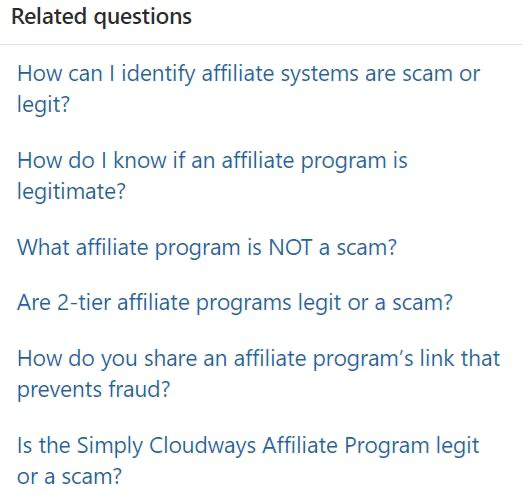
Encourage your affiliates to submit an answer. Their real-life experiences will demonstrate your program's benefits. This level of transparency builds trust and strengthens brand reputation.
Be Open to Promotion from Multiple Sources
Don't get caught up chasing only the biggest names in affiliate marketing. Working with a diverse network caters to different audience segments.
Work With Smaller Affiliates: Big-name affiliates often work with multiple brands with deep pockets, which means there's a lot of competition. Small affiliates typically promote only a handful of products. They also have a highly engaged audience with whom they have a personal connection. This can ultimately lead to higher conversion rates.
Moreover, small affiliates tend to be more flexible. They can quickly pivot their strategies in response to feedback, new trends, and market changes. This agility allows them to experiment with different approaches and adapt to what works best. As your partnership grows, small affiliates can scale their efforts more flexibly. They can increase their promotional activities to match your growth.
Leverage Influencer Marketing: Social media influencers hold a lot of power. In a Statista survey, about 37% of brands and marketing agencies stated they've worked with at least ten influencers. How to promote an affiliate program using influencers requires targeted execution. Choose influencers with established credibility and specific demographics to promote your program.
Always choose an influencer with a high engagement rate over follower count. Even with fewer followers, an influencer with a high engagement rate can drive more meaningful interactions. Check their content style, engagement metrics, and past collaborations. Prioritise authenticity. Avoid those who regularly advertise low-quality products. This can damage your brand image in the long run.
5. Integrate with Social Media
Social media has grown so vast that you need a solid affiliate marketing plan specific to social media platforms.
To avoid getting overwhelmed, segment your social media affiliate strategy.
Choose the Right Platform: There will be 5.85 billion social media site and app users by 2027. Every day, new social platforms emerge. You can't possibly use all platforms to promote your affiliate program. Pick your top five and focus your campaigns on those channels.
YouTube should be on the list. Using the top global video platform is the easiest way to spread tutorials and information about your program. You can create multiple videos tackling your program's benefits, perks, rates, and unique features. To reach a broader global audience, utilize an instant video translator to make your content available in multiple languages, helping expand your program’s visibility. Instagram, Facebook, TikTok, and LinkedIn are top social networking sites with millions of users. For Instagram, adding hyperlinks in captions and comments is still disabled, but potential affiliates can put your program link on their bio using a link in bio tool. Facebook is great if your target affiliates are older millennials. Alternatively, lean on TikTok to target Gen Z and younger affiliates. LinkedIn is best for B2B brands. It's also a great place to find industry experts. So, social media marketing agencies can help you strategize and manage your social presence across all platforms. Moreover, explore X, Reddit, and Pinterest to expand your reach. Including WhatsApp marketing in your strategy can significantly boost engagement rates, as it offers direct communication with your audience.
When choosing social platforms, consider your sales process, target audience, and content type. For example, if you’re an eCommerce brand, prioritise image-centric platforms like Instagram and Pinterest. For content type, each platform has a "speciality," so find the one that aligns with your program. If you're promoting a fashion affiliate program, you can use Instagram and TikTok to showcase stunning visuals, YouTube to create longer video content, and LinkedIn to showcase your niche expertise.
Post and Interact Regularly: It comes across poorly when brands keep promoting their program repeatedly without engaging with their audience. Engagement with the audience balances out regular promotion. The rule is "never post just to post." While it depends on the platform, there's a decent number of times you can post on social media sites without being overkill.
In addition to promoting your program, run contests, offer discounts, post memes, share or repost posts from industry experts, like a post, and leave a comment. It's not just about being active on social platforms but also about "humanising" your program. If you have active and interactive social platforms, potential affiliates will view your program as attainable.
Reposting or engaging on content posted by your affiliates is also a great way to drive engagement in your affiliate program. Your affiliates work to earn money from your program. However, they also have business goals, such as getting more followers. Potential affiliates will take notice when you support them by reposting relevant content or even just leaving an emoji. If they're deciding between programs, this level of engagement can be the clincher for them when choosing your program. Resharing also encourages other followers to do the same thing. And when you get a shoutout from an affiliate, it helps increase brand awareness.
See how SkillShare does it:
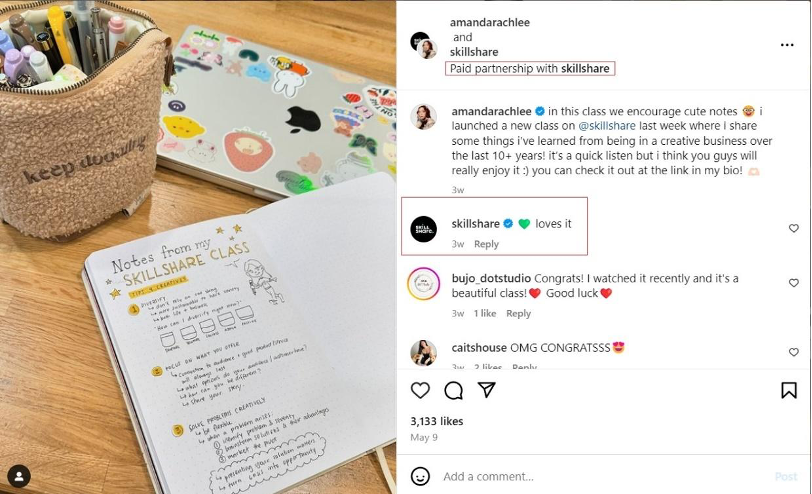
6. Make Use of Smaller Marketing Channels
Exploring smaller marketing channels offers a wealth of value beyond the mainstream options.
Join Affiliate Forums and Groups
Affiliate communities are a goldmine for connection and program promotion. Take the time to explore forums like the Reddit Affiliate Marketing Community.
Be an Active Participant: With 178K members, the Reddit community can be overwhelming. Start by reading the rules so you don't get banned. Then, filter by topics to determine where you want to engage in ongoing discussions. If you come across a question from a potential affiliate that you can confidently answer or share your insight, do so. Contribute relevant content, and don't be stingy with praises. You want to be visible in the forums and provide valuable insights about your industry and program. The goal is to establish yourself as a thought leader and your program as trustworthy.
Network with Established Affiliates: Look for industry experts like Missy Ward, Matt Diggity and other successful affiliate marketers in your niche. Study how they've overcome challenges in affiliate marketing. Learn from their experience. And whenever possible, explore potential partnerships with them.
Partner Up with Related Brands
Strategic partnerships with other brands can significantly improve your brand reputation.
Identify Complementary Businesses: Look for businesses that offer non-competing products or services that complement your program. For instance, if your affiliate program is a travel booking platform like Expedia, you can partner with tour companies or local activity providers to offer a complete vacation package. You can cross-promote with a complementing program using influencer posts, promotional videos, giveaways, and contests. For businesses in the leisure industry, partnering with water parks using waterpark booking software can provide customers with an easy booking experience. You and your partner brand can co-promote on each other's websites, social media channels, and email marketing campaigns.
Offer Exclusive Incentives: Design a time-sensitive incentive program with your brand partner. Create a tiered commission structure where affiliates unlock higher commission rates when they successfully promote both brands together within the timeframe. You and your partner can offer exclusive product bundles or early access to new product launches. Developing a co-branded incentive program is beneficial for both brands as it cultivates collaboration that can lead to a deeper partnership that is also beneficial to affiliates.
So, how do you promote an affiliate program? Establish a base, broaden your reach, enhance visibility, foster trust, and use social media and niche channels. And, of course, use top-tier affiliate software like Trackdesk to make your affiliate work easier.

I have a passion for storytelling. I believe that a good story delivers value while capturing, influencing, and sustaining its intended audience. This has always been, and always will be, my primary aim as a writer.
